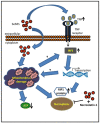Biogenic Selenium Nanoparticles in Biomedical Sciences: Properties, Current Trends, Novel Opportunities and Emerging Challenges in Theranostic Nanomedicine
- PMID: 36770385
- PMCID: PMC9921003
- DOI: 10.3390/nano13030424
Biogenic Selenium Nanoparticles in Biomedical Sciences: Properties, Current Trends, Novel Opportunities and Emerging Challenges in Theranostic Nanomedicine
Abstract
Selenium is an important dietary supplement and an essential trace element incorporated into selenoproteins with growth-modulating properties and cytotoxic mechanisms of action. However, different compounds of selenium usually possess a narrow nutritional or therapeutic window with a low degree of absorption and delicate safety margins, depending on the dose and the chemical form in which they are provided to the organism. Hence, selenium nanoparticles (SeNPs) are emerging as a novel therapeutic and diagnostic platform with decreased toxicity and the capacity to enhance the biological properties of Se-based compounds. Consistent with the exciting possibilities offered by nanotechnology in the diagnosis, treatment, and prevention of diseases, SeNPs are useful tools in current biomedical research with exceptional benefits as potential therapeutics, with enhanced bioavailability, improved targeting, and effectiveness against oxidative stress and inflammation-mediated disorders. In view of the need for developing eco-friendly, inexpensive, simple, and high-throughput biomedical agents that can also ally with theranostic purposes and exhibit negligible side effects, biogenic SeNPs are receiving special attention. The present manuscript aims to be a reference in its kind by providing the readership with a thorough and comprehensive review that emphasizes the current, yet expanding, possibilities offered by biogenic SeNPs in the biomedical field and the promise they hold among selenium-derived products to, eventually, elicit future developments. First, the present review recalls the physiological importance of selenium as an oligo-element and introduces the unique biological, physicochemical, optoelectronic, and catalytic properties of Se nanomaterials. Then, it addresses the significance of nanosizing on pharmacological activity (pharmacokinetics and pharmacodynamics) and cellular interactions of SeNPs. Importantly, it discusses in detail the role of biosynthesized SeNPs as innovative theranostic agents for personalized nanomedicine-based therapies. Finally, this review explores the role of biogenic SeNPs in the ongoing context of the SARS-CoV-2 pandemic and presents key prospects in translational nanomedicine.
Keywords: SeNPs; biomedical applications; biosynthesis; nanomedicine; pharmacokinetics; selenoproteins; theranostics.
Conflict of interest statement
The authors declare no conflict of interest.
Figures












Similar articles
-
Unveiling Green Synthesis and Biomedical Theranostic paradigms of Selenium Nanoparticles (SeNPs) - A state-of-the-art comprehensive update.Int J Pharm. 2024 Sep 5;662:124535. doi: 10.1016/j.ijpharm.2024.124535. Epub 2024 Jul 31. Int J Pharm. 2024. PMID: 39094922 Review.
-
Therapeutic applications of selenium nanoparticles.Biomed Pharmacother. 2019 Mar;111:802-812. doi: 10.1016/j.biopha.2018.12.146. Epub 2019 Jan 4. Biomed Pharmacother. 2019. PMID: 30616079 Review.
-
Biogenic Selenium Nanoparticles and Their Anticancer Effects Pertaining to Probiotic Bacteria-A Review.Antioxidants (Basel). 2022 Sep 27;11(10):1916. doi: 10.3390/antiox11101916. Antioxidants (Basel). 2022. PMID: 36290639 Free PMC article. Review.
-
Biogenic selenium nanoparticles: a comprehensive update on the multifaceted application, stability, biocompatibility, risk, and opportunity.Z Naturforsch C J Biosci. 2025 Feb 10. doi: 10.1515/znc-2024-0176. Online ahead of print. Z Naturforsch C J Biosci. 2025. PMID: 39920565 Review.
-
Exploring non-cytotoxic, antioxidant, and anti-inflammatory properties of selenium nanoparticles synthesized from Gymnema sylvestre and Cinnamon cassia extracts for herbal nanomedicine.Microb Pathog. 2024 Jul;192:106670. doi: 10.1016/j.micpath.2024.106670. Epub 2024 May 9. Microb Pathog. 2024. PMID: 38734323
Cited by
-
Selenium Species in Diabetes Mellitus Type 2.Biol Trace Elem Res. 2024 Jul;202(7):2993-3004. doi: 10.1007/s12011-023-03900-z. Epub 2023 Oct 25. Biol Trace Elem Res. 2024. PMID: 37880477 Free PMC article. Review.
-
A Review of the Antibacterial, Fungicidal and Antiviral Properties of Selenium Nanoparticles.Materials (Basel). 2023 Jul 30;16(15):5363. doi: 10.3390/ma16155363. Materials (Basel). 2023. PMID: 37570068 Free PMC article. Review.
-
The Toxicological Assessment of Anoectochilus burmannicus Ethanolic-Extract-Synthesized Selenium Nanoparticles Using Cell Culture, Bacteria, and Drosophila melanogaster as Suitable Models.Nanomaterials (Basel). 2023 Oct 22;13(20):2804. doi: 10.3390/nano13202804. Nanomaterials (Basel). 2023. PMID: 37887954 Free PMC article.
-
Antioxidant Metabolism Pathways in Vitamins, Polyphenols, and Selenium: Parallels and Divergences.Int J Mol Sci. 2024 Feb 23;25(5):2600. doi: 10.3390/ijms25052600. Int J Mol Sci. 2024. PMID: 38473850 Free PMC article. Review.
-
Green synthesis of nanoselenium by Ferula assa-foetida (L.) root extract: Docking study, antimicrobial activity, and its role as a biostimulant in Vicia faba (L.) seedlings.BMC Plant Biol. 2025 Jul 19;25(1):932. doi: 10.1186/s12870-025-06954-4. BMC Plant Biol. 2025. PMID: 40684143 Free PMC article.
References
-
- Jamkhande P.G., Ghule N.W., Bamer A.H., Kalaskar M.G. Metal nanoparticles synthesis: An overview on methods of preparation, advantages and disadvantages, and applications. J. Drug Deliv. Sci. Technol. 2019;53:101174. doi: 10.1016/j.jddst.2019.101174. - DOI
Publication types
LinkOut - more resources
Full Text Sources
Miscellaneous

